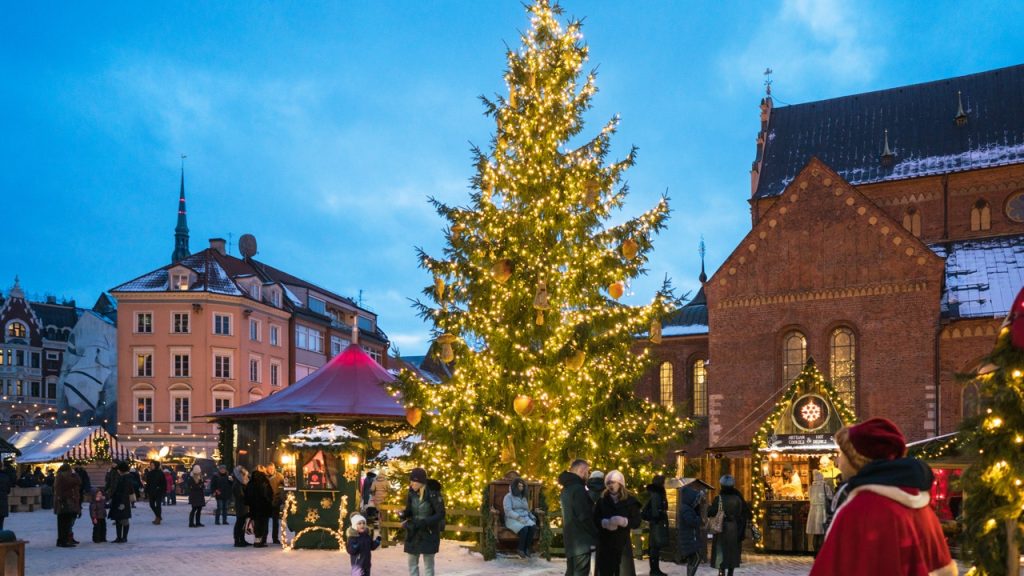The shimmering, ornamented Christmas tree, a centerpiece of holiday celebrations in homes worldwide, has a history steeped in both tradition and debate. Pinpointing the exact origin of the first decorated Christmas tree remains a point of contention, with two Baltic nations, Latvia and Estonia, vying for the title. While both countries boast vibrant Christmas traditions and festive winter landscapes, their claims to the first Christmas tree differ by nearly a century. This historical ambiguity adds a layer of intrigue to the beloved holiday symbol.
Latvia’s claim rests on documentation by the National Christmas Tree Association, which cites Riga as the location of the first recorded decorated Christmas tree in 1510. The Brotherhood of the Blackheads, an association of merchants and traders, is credited with adorning a tree with artificial roses, placing it in the marketplace for a celebratory dance, and ultimately setting it ablaze. A plaque in Riga commemorates this event, proclaiming it the site of the "First New Year’s Tree" in multiple languages. Each year, Riga continues the tradition by displaying a Christmas tree in the location where the first is said to have stood.
Estonia, however, challenges Latvia’s claim, asserting that Tallinn hosted the first Christmas tree in 1441, nearly seventy years prior to the Riga event. Visit Tallinn and other sources also attribute the tradition to the Brotherhood of the Blackheads, suggesting they erected a tree in Tallinn Town Square. Like Riga, Tallinn maintains the annual tradition of a prominent Christmas tree in its main square during the holiday season. Both cities embrace the festive spirit, offering Christmas markets, elaborate decorations, and lively performances, transforming into winter wonderlands despite the often frigid temperatures and frequent snowfall, virtually guaranteeing a white Christmas for visitors.
While the origin of the first public Christmas tree remains a friendly rivalry between Latvia and Estonia, the tradition of bringing decorated trees into homes is more definitively traced to 17th-century Germany. The National Christmas Tree Association identifies Germany as the birthplace of this custom, where early decorations included apples, red paper strips, and gilded nuts. This practice likely evolved from pre-Christian winter solstice traditions involving evergreen boughs brought indoors to symbolize life and hope during the darkest months of the year. These early indoor trees laid the foundation for the Christmas tree tradition we know today.
The Christmas tree tradition crossed the Atlantic to the United States in the 19th century, gradually gaining popularity throughout the country. Initially, decorated trees were primarily found in German-American communities, but their festive charm soon captivated a wider audience. The tradition truly took root in American culture when the first Christmas tree farm opened its doors in 1901. W.V. McGalliard’s pioneering venture in New Jersey, planting 25,000 Norway spruce trees, marked a significant milestone in the commercialization of Christmas trees in the United States. This laid the groundwork for the widespread availability of Christmas trees, transforming them from a relatively rare sight to a ubiquitous symbol of the holiday season.
Today, approximately 15,000 Christmas tree farms operate across the United States, providing families with the annual ritual of selecting the perfect tree to adorn their homes. This tradition has become deeply ingrained in American culture, representing not just the festive spirit of Christmas but also the cherished values of family, togetherness, and the anticipation of the holiday season. From its debated origins in medieval Europe to its widespread adoption in modern America, the Christmas tree has evolved into a symbol of enduring holiday cheer, bringing joy and a touch of magic to homes around the world.

